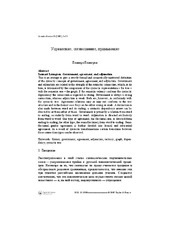Upravlenie, soglasovanie, primykanie = Government, agreement, and adjunction
Permanent link
https://hdl.handle.net/10037/2165Date
2007Type
Journal articleTidsskriftartikkel
Peer reviewed
Author
Lönngren, LennartAbstract
This is an attempt to give a strictly formal and semantically motivated definition
of the syntactic concepts of government, agreement, and adjunction. Government
and adjunction are related to the strength of the syntactic connection, which, in its
turn, is determined by the comparison of the syntactic representation – the tree –
with the semantic one – the graph. If the semantic valency confirms the syntactic
dependency the connection is regarded as strong. Government is always a strong
connection, whereas adjunction is weak. Both are, however, in conformity with
the syntactic tree. Agreement relations may or may not conform to the tree
structure and in the former case they can be either strong or weak. A distinction is
also made between word and its ending; a syntactic dependency arrow can be
directed to or from either of these. Government is primarily a relation from word
to ending, secondarily from word to word. Adjunction is directed exclusively
from word to word. One type of agreement, the flectional one, is directed from
ending to ending, the other type, the semi-flectional, from word to ending. Semiflectional
gender agreement is further divided into lexical and referential
agreement. As a result of syntactic transformations certain transitions between
these connection types can be observed.


 English
English norsk
norsk